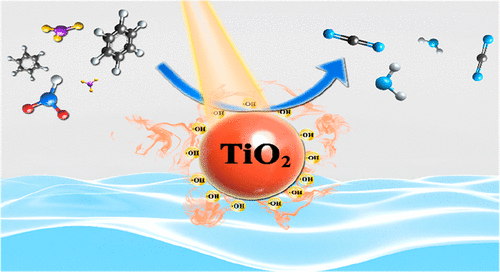当前位置:
X-MOL 学术
›
ACS ES&T Eng.
›
论文详情
Our official English website, www.x-mol.net, welcomes your
feedback! (Note: you will need to create a separate account there.)
Controlling the Gas–Water Interface to Enhance Photocatalytic Degradation of Volatile Organic Compounds
ACS ES&T Engineering ( IF 7.4 ) Pub Date : 2021-05-11 , DOI: 10.1021/acsestengg.1c00120 Zhenmin Xu 1, 2 , Wei Chai 3 , Jiazhen Cao 1 , Fengjiao Huang 1 , Tong Tong 1 , Suyuan Dong 1 , Qianyu Qiao 1 , Liyi Shi 2 , Hexing Li 1 , Xufang Qian 4 , Zhenfeng Bian 1
ACS ES&T Engineering ( IF 7.4 ) Pub Date : 2021-05-11 , DOI: 10.1021/acsestengg.1c00120 Zhenmin Xu 1, 2 , Wei Chai 3 , Jiazhen Cao 1 , Fengjiao Huang 1 , Tong Tong 1 , Suyuan Dong 1 , Qianyu Qiao 1 , Liyi Shi 2 , Hexing Li 1 , Xufang Qian 4 , Zhenfeng Bian 1
Affiliation

|
The gas–water interface plays an important role in the photocatalytic degradation of volatile organic compounds (VOCs). Herein, a novel photocatalytic reactor with a tunable gas–water interface was designed and utilized to investigate the performance of photocatalytic degradation of VOCs. The relationship between the key operating parameters of the reactor and VOCs mineralization was investigated in detail with toluene as a model pollutant. The results showed that a tunable gas–water interface was formed in the process of atomized spray photocatalytic oxidation. Furthermore, the photocatalyst was easily excited by light, generating more free radicals, which was conducive to improving the mineralization performance of toluene and the durability of the catalyst. The intermediates of the toluene reaction were analyzed by photoacoustic spectroscopy (PAS), total organic carbon (TOC), and electrospray ionization–ion trap mass spectrometry (ESI–MS). The results show that abundant hydroxyl radicals are formed at the gas–water interface, which is beneficial to the opening of the benzene ring and greatly reduces the formation of toxicity and byproducts. Simultaneously, we investigated the degradation performance of acetone, formaldehyde, and n-hexane in the reactor. This provides a new strategy for using photocatalytic technology to purify industrial flue gas and indoor air.
中文翻译:

控制气-水界面以增强挥发性有机化合物的光催化降解
气水界面在光催化降解挥发性有机化合物(VOCs)中起着重要作用。在此,设计并利用具有可调气-水界面的新型光催化反应器来研究光催化降解 VOC 的性能。以甲苯为模型污染物,详细研究了反应器关键运行参数与VOCs矿化的关系。结果表明,雾化喷雾光催化氧化过程中形成了可调的气-水界面。此外,光催化剂容易被光激发,产生更多的自由基,有利于提高甲苯的矿化性能和催化剂的耐久性。通过光声光谱 (PAS)、总有机碳 (TOC) 和电喷雾电离-离子阱质谱 (ESI-MS) 分析甲苯反应的中间体。结果表明,气水界面处形成了大量的羟基自由基,有利于苯环的打开,大大减少了毒性和副产物的形成。同时,我们研究了丙酮、甲醛和Ñ己烷在反应器中。这为利用光催化技术净化工业烟气和室内空气提供了新的策略。
更新日期:2021-07-09
中文翻译:

控制气-水界面以增强挥发性有机化合物的光催化降解
气水界面在光催化降解挥发性有机化合物(VOCs)中起着重要作用。在此,设计并利用具有可调气-水界面的新型光催化反应器来研究光催化降解 VOC 的性能。以甲苯为模型污染物,详细研究了反应器关键运行参数与VOCs矿化的关系。结果表明,雾化喷雾光催化氧化过程中形成了可调的气-水界面。此外,光催化剂容易被光激发,产生更多的自由基,有利于提高甲苯的矿化性能和催化剂的耐久性。通过光声光谱 (PAS)、总有机碳 (TOC) 和电喷雾电离-离子阱质谱 (ESI-MS) 分析甲苯反应的中间体。结果表明,气水界面处形成了大量的羟基自由基,有利于苯环的打开,大大减少了毒性和副产物的形成。同时,我们研究了丙酮、甲醛和Ñ己烷在反应器中。这为利用光催化技术净化工业烟气和室内空气提供了新的策略。









































 京公网安备 11010802027423号
京公网安备 11010802027423号